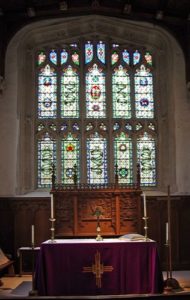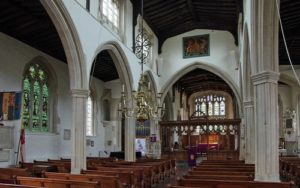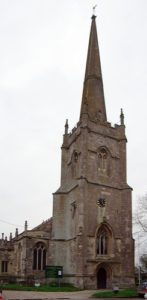Lechlade is rather a work-a-day town on the upper reaches of the River Thames with a good range of shops. In the 13thC, it was an important wool town and there was a priory and a church here. The priory was dissolved in 1472 when a brand new church was built. In 1510, fire destroyed the roof and interior. During the rebuilding, a clerestory was added. The church has remained virtually unchanged since then, apart from a spire and south porch being added in the 16thC. It has been described as one of the “six finest churches in Gloucestershire”.
It has a tall square battlemented tower with corner pinnacles and tall slender spire. The nave is battlemented while the chancel has an open carved balustrade. This and the side aisle are decorated with pinnacles. It is worth walking round the outside to look at the detail of the carving, especially the gargoyles.
Entry is through the west door. Inside it is a big church with tall fluted pillars with pointed arches. The clear glass clerestory windows make the inside very light. There is a simple wood beamed roof. Hanging from the ceiling is a large brass chandelier dating from 1730.
The 15thC octagonal font still has traces of paint in the carvings. The stone pulpit is 19thC. Near it is a brass of John Townsend, a wealthy wool merchant.
There are two old carvings which are thought to have come either from the priory or the older church. One depicts the martyrdom of St Agatha with a sword thrust through her naked breasts. The other stone is square and is thought to represent a baptism scene, although it is badly damaged.
Above the chancel arch is the Royal Coat of Arms. The rood screen has simple base panels and delicate tracery above. On top is a stylised cross with small carved angels on either side.
The base of the walls of the sanctuary are panelled, with nicely carved tops. The wooden reredos below the stained glass east window has a carving of Anges Dei with a cross in the centre, with the symbols of the four evangelists at the sides.
The chancel roof has elaborately carved corbels. The bosses have been recently recoloured and are very colourful. They include ten angels with the instruments of the passion, each with different coloured wings.
On the wall is a large monument to Mrs Anne Simons with weeping putti beside a draped obelisk with a cameo of her on it. There is also a roll of honour for the dead of both world wars.
The vestry door is mentioned in all the guides as it has a carving of a pomegranate, the symbol of Catherine of Aragon. We weren’t sure which one was the pomegranate, but it is a nicely carved door set under an ogee arch.
The east window in the south aisle contains fragments of medieval glass. Beneath it is a panelled wood reredos with carvings of Agnes Dei, Crucifixion the Virgin and St John and what looks like three wool combs.
The is an elegant church and well cared for but somehow it didn’t fire the imagination. Possibly it was at the end of a long day and we didn’t see it at its best. It wouldn’t be in our top six churches of Gloucestershire.
The church is open daylight hours and there is free parking in the market place outside, although this can get busy.










